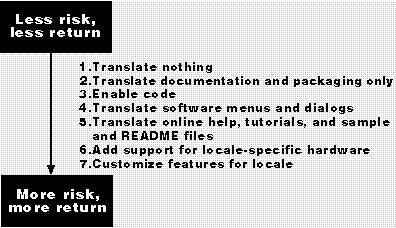
Glossary
Internationalizing core code is a basic requirement for software that will ship outside of your native country. You can vary the level of effort and expense devoted to localization, however, depending on the target market and the application type. (See Figure 1-4 below.) Some markets, such as Eastern European countries and the People's Republic of China, are currently comparatively small, so shipping a product there is considered an investment for the future. Other markets, such as France and Germany, are well established, and breaking into them requires a large investment and a commitment to high standards. Still other markets, such as Korea and the Arabic-speaking countries, are small but growing rapidly. It is possible to establish a presence in small markets by shipping a partially localized application quickly and following it up later with a more fully localized edition of the same application or its next revision. For example, Microsoft traditionally ships an English edition of a new Windows operating system enabled for Central and Eastern European character sets within days of shipping the US product. Localized editions generally follow within six months.
At Microsoft, subsidiary marketing managers decide the level of localization for each language edition of Windows. Developers and translators provide the marketing managers with an estimate of how much time and money each level will require. Then the subsidiaries and product teams decide whether the potential return is worth the cost. Take a look at Appendix P, which lists localized editions of Windows and their ship dates, to see the decisions Microsoft has made so far.

Figure 1-4 Levels of localization.
The first two levels of localization listed in Figure 1-4, translating nothing and translating documentation and packaging only, involve little development cost—at most, developers will be called upon to explain technical issues to translators. The next level, enabling the code, involves no translation cost. The term "enabling" applies most often to software that was originally designed for Western European languages. Enabled software allows users to create documents in their own languages, even if the user interface isn't localized. Code for Middle Eastern or Far Eastern language editions of such programs must be altered to handle input, layout, display, editing, and printing of Middle Eastern or Far Eastern language text. (See Chapters 3, 6 and 7 for a more detailed description of what is involved.) Screen savers, multimedia titles, and other programs that do not allow the user to enter or edit text do not require enabling.
If an English-language edition of your product exists, consider using it to test the waters in markets where users will buy a product with an English-language user interface until a fully localized edition is available. The following list gives some guidelines for determining the markets in which an English-language user interface is acceptable:
In markets where only translated products are successful, do a partial translation if you want to ship quickly or don't want to pay the cost of a full translation. As a general rule, the more involved the translation, the more questions developers must answer and the more bugs developers must fix.
In more competitive markets, you will need to customize features and, in some cases, add support for hardware that is sold locally.